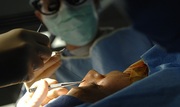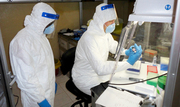|
|
|
|
|
|
|
For military service members suffering eye trauma anywhere in the world, it is important to find a facility where an ophthalmic surgeon can operate on the eye quickly. It is also important to make sure that patients get timely follow-on care with the right ocular specialists as service members make their way home. Coordinating that care can be challenging.
|
|
|
|
Service members face many types of obstacles in their daily work. Exercises can result in strained ligaments and fractured bones; combat zones can produce concussions and amputations; exposure to contaminated water sources can spread diarrheal diseases. The Armed Forces Health Surveillance Center (AFHSC) works to counter these threats with surveillance information that can help maintain and enhance the health of service members and their families. AFHSC joined the Defense Health Agency Aug. 24.
|
|
|
|
|
|
|
A team of research scientists at the Department of Defense Biotechnology High Performance Computing Software Applications Institute, or DOD BHSAI, Telemedicine and Advanced Technology Research Center, U.S. Army Medical Research and Materiel Command on Fort Detrick, Maryland, are working to eliminate heat-related injuries to military service members.
|
|
|
|
|





